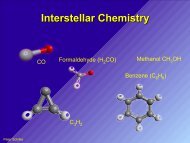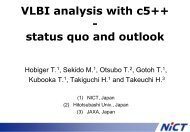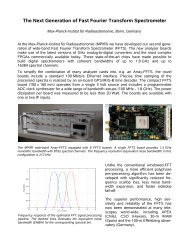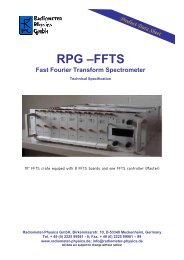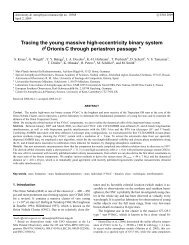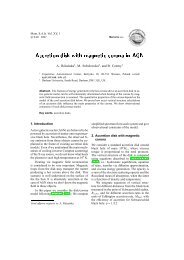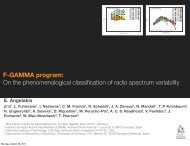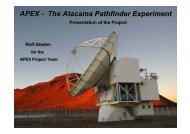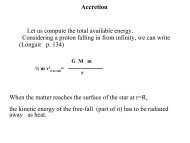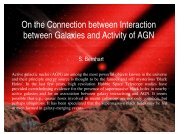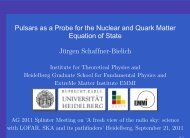178 B. Parise et al.: Models of <strong>HDO</strong> <strong>emission</strong>Table 2. Conversion factors of the line intensity in erg s −1 cm −2 into the velocity integrated main beam temperature T mb ∆v observed at theIRAM and JCMT telescopes respectively, for the five lines observed towards IRAS 16293−2422 (Parise et al. 2005). Last column quotes theT mb ∆v observed towards IRAS 16293–2422 (Parise et al. 2005). a Predicted flux <strong>from</strong> the model simply converted into K km s −1 using theconversion factor. b Predicted flux derived using an accurate convolution of the signal with the telescope beam.Transition Frequency Telescope Conversion coeff IRAS 16293–2422(GHz) 1 K km s −1 (T mb ∆v) (Kkm s −1 ) (K km s −1 ) (K km s −1 )(erg s −1 cm −2 ) Conversion a Convolution b Obs c1 1,0 −1 1,1 80.578 IRAM 1.4 × 10 −17 0.19 0.21 0.403 1,2 −2 2,1 225.897 IRAM 4.1 × 10 −17 1.7 1.8 1.72 1,1 −2 1,2 241.561 IRAM 4.4 × 10 −17 1.5 1.5 2.02 2,0 −3 1,3 266.161 IRAM 4.9 × 10 −17 0.20 0.22 0.211 0,1 −0 0,0 464.924 JCMT 4.0 × 10 −16 6.3 5.4 5.5to 10 −9 . The 225 GHz line <strong>emission</strong> then al<strong>low</strong>s us to constrainthe value of x warm (independantly of the evaporation temperature).Indeed, converting the intensity observed by Parise et al.(2005), we find 7 × 10 −17 erg s −1 cm −2 , which with the conditionx cold <strong>low</strong>er than 10 −9 , constrains the abundance of <strong>HDO</strong>in the warm envelope to a value around 10 −7 . The full modelingleads to x warm = (1 ± 0.3) × 10 −7 ,andtoa3σ upper limit onx cold of 10 −9 (Parise et al. 2005).Table 2 compares the predicted fluxes derived <strong>from</strong> themodel by both using the simple conversion flux for a pointlikesource and an accurate convolution with the telescope(IRAM or JCMT) beam, to the observations performed towardsIRAS 16293−2422 (Parise et al. 2005). As expected thesimple conversion works reasonably well for the high-lyinglines, as they originate <strong>from</strong> the small inner envelope (smallenough compared to the beam size to be approximated by apoint). The accuracy of the conversion for the ground line at464 GHz is less good as some of the <strong>emission</strong> originates <strong>from</strong>the outer envelope, which is affected by the convolution of thetelescope beam. Nevertheless the simple conversion is still accurateto 15% because for this testcase, the <strong>HDO</strong> abundance isthree orders of magnitude <strong>low</strong>er in the outer envelope than theinner envelope. The conversion would become critical whenthe abundance in the cold envelope is not <strong>low</strong> compared to thewarm contribution.The plots of Figs. 4–6 can be used with single dish observationswithout the need for convolution, for the signal, originatingin the warm part of the envelope, is likely to be encompassedby the telescope beam.5.2. The <strong>low</strong> luminosity source case: L1448 mmThe previous predictions are of course dependent on the physicalstructure considered for the source. As an example, we alsoplotted the contours for a <strong>low</strong>-luminosity source, L1448 mm,for which physical characteristics can be found in Jørgensenet al. (2002) or Maret et al. (2004). The results are presented inAppendix B. The contours roughly look the same, except thatthe <strong>emission</strong> is weaker in L1448 mm.5.3. Are space-based telescope observations towards<strong>low</strong>-<strong>mass</strong> protostars necessary?We saw in the previous sections that the observation of thestudied lines <strong>from</strong> the ground al<strong>low</strong>s one to perfectly constrainthe inner <strong>HDO</strong> abundance. However, the outer <strong>HDO</strong> abundancecan only be constrained using <strong>low</strong>er energy transitions.Among the studied lines, only the 464 GHz can provide, insome specific conditions (namely when the outer abundanceis not too <strong>low</strong> compared with the inner abundance) some informationon x cold . Unfortunately, the transitions that will be observable<strong>from</strong> space are at higher energy (see Fig. 2). They willhence only provide information on the inner abundance, whichis already correctly constrained with the transitions observedwith ground-based telescopes. Moreover observations <strong>from</strong> theground, when possible, have to be preferred owing to the betterspatial resolution. Table 3 lists the integration time required toobserve some selected transitions with a peak signal to noiseof 5, at a resolution of 0.5 km s −1 , with the various instrumentsIRAM 30 m, JCMT and HSO/HIFI. Note that in each case, onlyone receiver was assumed (single polarization mode) so that theintegration time could in principle be <strong>low</strong>ered by a factor of √ 2if the observations are carried out in double polarization mode.An average of 2 mm of water vapor has been assumed at theIRAM 30 m, where the average elevation of the source is 25 ◦and 70 ◦ respectively for IRAS 16293 and L1448 mm. Weatherband 2 was assumed at JCMT, with a zenith angle of 40 and20 respectively. An efficiency factor of 0.125 was assumed forHIFI, as predicted in chopping mode.These predictions show that for sources as bright asIRAS 16293, observations can be carried out <strong>from</strong> the ground,and no Herschel time is thus necessary. But in the case of a<strong>low</strong>-luminosity protostar, where the same abundance profileof <strong>HDO</strong> was assumed, integration times start to become prohibitive<strong>from</strong> the ground. The 225 and 241 GHz lines mayremain observable, using double polarisation receivers. Notethat the integration time required with HIFI is prohibitive, theonly reasonable transition being the 995 GHz. Thus, in thecase of <strong>low</strong>-luminosity source, neither ground-based telescopesnor HSO/HIFI seem to be sensitive enough. The interferometerALMA might provide in this case the only possibility ofconstraining the <strong>HDO</strong> abundance.
B. Parise et al.: Models of <strong>HDO</strong> <strong>emission</strong> 179Table 3. Integration time required to detect the <strong>HDO</strong> lines with a peaksignal over noise of 5 (see text). Note that only one receiver was assumed,so in principle those times can be <strong>low</strong>ered by a factor √ 2byusing a double polarization setup.Transition IRAM 30 m JCMT HSO/HIFIIRAS 16293 (30 L ⊙ )80 GHz 5.6 h225 GHz 15 min241 GHz 30 min464 GHz 29 min490 GHz 21 min 7 min509 GHz 34 h ∗ 104 min893 GHz 16 min995 GHz 5 minL1448 mm (5 L ⊙ )80 GHz 3500 h225 GHz 110 h241 GHz 227 h464 GHz 185 h490 GHz 132 h 73 h509 GHz 1562 h ∗ 471 h893 GHz 59 h995 GHz 16 h∗ The sensibility drops on the edge of the band.6. ConclusionsWe reported theoretical predictions of the deuterated water line<strong>emission</strong> <strong>from</strong> the <strong>envelopes</strong> of <strong>low</strong> <strong>mass</strong> protostars. In thisstudy, we have focused only on the envelope <strong>emission</strong>, neglectingany <strong>HDO</strong> <strong>emission</strong> <strong>from</strong> the outf<strong>low</strong>s, which is expected tobe of minor importance based on theoretical and observationalarguments. We have shown that the simultaneous observationsof appropriately selected transitions permit us to approximatelyconstrain the <strong>HDO</strong> abundance in the outer cold and inner warmparts of the envelope. The uncertainty on the evaporation temperaturemostly translates into an uncertainty on the inner abundance.The inner abundance can however be quite accuratelydetermined using the 225 GHz line for which the <strong>emission</strong> hasbeen shown to be independent of the evaporation temperature.The most important result of the present study is that,for bright <strong>low</strong>-<strong>mass</strong> protostars (L > 10 L ⊙ ), observationsfeasible <strong>from</strong> ground telescopes are sufficient to constrainthe <strong>HDO</strong> abundance profile and evaporation temperature,and no HSO observations are required. In the case of <strong>low</strong>luminosityprotostars (L < 10 L ⊙ ), both present ground-basedtelescopes and HSO seem to lack the sensitivity necessary toobserve <strong>HDO</strong> lines in a reasonable integration time. The <strong>HDO</strong>abundance profile and evaporation temperature will probablybe directly constrained by future high resolution observationswith the large sub/millimeter interferometer ALMA.Acknowledgements. We wish to thank the anonymous referee for veryuseful comments that helped to improve this article.ReferencesBergin, E. A., Neufeld, D. A., & Melnick, G. J. 1999, ApJ, 510, L145Bottinelli, S., Ceccarelli, C., Lefloch, B., et al. 2004a, ApJ, 615, 354Bottinelli, S., Ceccarelli, C., Neri, R., et al. 2004b, ApJ, 617, L69Caux, E., et al. in prep., A&ACazaux, S., Tielens, A. G. G. M., Ceccarelli, C., et al. 2003, ApJ, 593,L51Ceccarelli, C., Hollenbach, D. J., & Tielens, A. G. G. M. 1996, ApJ,471, 400Ceccarelli, C., Castets, A., Loinard, L., Caux, E., & Tielens, A. G.G. M. 1998, A&A, 338, L43Ceccarelli, C., Castets, A., Caux, E., et al. 2000a, A&A, 355, 1129Ceccarelli, C., Loinard, L., Castets, A., Tielens, A. G. G. M., & Caux,E. 2000b, A&A, 357, L9Ceccarelli, C., Maret, S., Tielens, A. G. G. M., Castets, A., & Caux,E. 2003, A&A, 410, 587Clough, S. A., Beers, Y., Klein, G. P., & Rothman, L. S. 1973, J. Chem.Phys., 59, 2254Dartois, E., Thi, W.-F., Geballe, T. R., et al. 2003, A&A, 399, 1009Gibb, E. L., Whittet, D. C. B., Boogert, A. C. A., & Tielens,A. G. G. M. 2004, ApJS, 151, 35Green, S. 1989, ApJS, 70, 813Jørgensen, J. K., Schöier, F. L., & van Dishoeck, E. F. 2002, A&A,389, 908Kuan, Y., Huang, H., Charnley, S. B., et al. 2004, ApJ, 616, L27Lis, D. C., Roueff, E., Gérin, M., et al. 2002, ApJ, 571, L55Maret, S., Ceccarelli, C., Caux, E., Tielens, A. G. G. M., & Castets,A. 2002, A&A, 395, 573Maret, S., Ceccarelli, C., Caux, E., et al. 2004, A&A, 416, 577Maret, S., Ceccarelli, C., Tielens, A., et al. 2005, A&A, submittedNeufeld, D. A., & Kaufman, M. J. 1993, ApJ, 418, 263Parise, B., Ceccarelli, C., Tielens, A. G. G. M., et al. 2002, A&A, 393,L49Parise, B., Simon, T., Caux, E., et al. 2003, A&A, 410, 897Parise, B., Castets, A., Herbst, E., et al. 2004, A&A, 416, 159Parise, B., Caux, E., Castets, A., et al. 2005, A&A, 431, 547Roberts, H., & Millar, T. J. 2000, A&A, 361, 388Roberts, H., Herbst, E., & Millar, T. J. 2003, ApJ, 591, L41Rodgers, S. D., & Charnley, S. B. 2003, ApJ, 585, 355Schöier, F. L., Jørgensen, J. K., van Dishoeck, E. F., & Blake, G. A.2002, A&A, 390, 1001Schöier, F. L., Jørgensen, J. K., van Dishoeck, E. F., & Blake, G. A.2004, A&A, 418, 185Shu, F. H. 1977, ApJ, 214, 488Stark, R., Sandell, G., Beck, S. C., et al. 2004, ApJ, 608, 341van der Tak, F. F. S., Schilke, P., Müller, H. S. P., et al. 2002, A&A,388, L53Vastel, C., Phillips, T. G., Ceccarelli, C., & Pearson, J. 2003, ApJ, 593,L97



